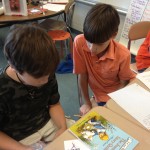The Value of Partnership
September 25, 2013 | Posted in: Class Updates
As much as I want students to learn from me, I absolutely want them to learn from one another. Throughout the school year, you will see instances of me having students collaborate with one or more classmates for a variety of purposes including reading response, checking work, problem solving, and much more. Kids often have a wonderful ability to explain concepts to one another in ways that are clear and understandable. Partnerships are valuable to all students – in mixed-ability groupings (one of several ways that I form partnerships), strong students better understand material when they need to explain it to their peers, and students who may be struggling may feel more at-ease sitting with a trusted friend, not the teacher. Plus, collaborative work teaches valuable life skills, including how to compromise, how to explain your reasons, and most importantly how to genuinely work together. (This is always a challenge for fourth graders, as they often view “working together” as working side by side to each do the same work, or to divide the work in half. In our class, “working together” should never be silent, and everyone should be equally involved in all parts of the task.) Finally, collaboration has a key role in the “gradual release” model of instruction, in which learning shifts from being teacher led (when new skills are introduced), to small-group based (for practice), to independent application.
This week, students collaborated to identify the main problem in texts. We started off by reading and discussing a story together (Melissa Parkington’s Beautiful, Beautiful Hair), and we wrote a shared response as a whole class. Then, as partners, students read and wrote similar responses to the story The Josefina Story Quilt, which is one of my favorite books to use throughout the year. (See photos, below.) Today, we looked at our new Short Answer Response (SAR) rubric, and partnerships began to share their responses. As a class, we looked at strengths and weaknesses of the responses, and we scored them together (so kids can begin to calibrate their understanding of how they are evaluated). To do this successfully, kids need to have a certain level of respect and tact in their interaction with others, as well as an understanding that suggestions and constructive criticisms are not personal attacks. So far, the kids are doing very well in this area, and I am eager to see them continue to grow in facilitated partnerships as the year progresses.
Leave a Reply
You must be logged in to post a comment.




